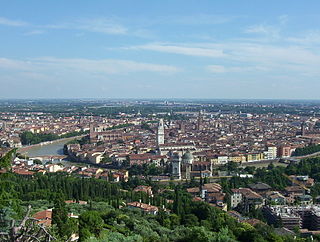
The Duchy of the Archipelago, also known as Duchy of Naxos or Duchy of the Aegean, was a maritime state created by Venetian interests in the Cyclades archipelago in the Aegean Sea, in the aftermath of the Fourth Crusade, centered on the islands of Naxos and Paros. It included all the Cyclades. In 1537, it became a tributary of the Ottoman Empire, and was annexed by the Ottomans in 1579; however, Christian rule survived in islands such as Sifnos and Tinos.

Events in the history of Verona, in Italy.

Othon de la Roche, also Otho de la Roche, was a Burgundian nobleman of the De la Roche family from La Roche-sur-l'Ognon. He joined the Fourth Crusade and became the first Frankish Lord of Athens in 1204. In addition to Athens, he acquired Thebes by around 1211.
The Treaty of Orvieto was an agreement made in 1281 between Charles I of Sicily, Giovanni Dandolo, Doge of Venice, and Philip of Courtenay, titular Latin Emperor, for recovery of the Latin Empire, with the blessing of the Papacy. Intended to restore Latin domination, both civil and ecclesiastical, to Greece, it was forestalled by the War of the Sicilian Vespers, which diverted the resources of Charles to the recovery of Sicily.

Anthony le Flamenc was an early 14th-century Frankish knight and lord of Karditsa in the region of Boeotia, in the Duchy of Athens.

Guglielma Pallavicini, the Lady of Thermopylae, was the last Pallavicino heir to rule in Bodonitsa, in Frankish Greece.
Oberto, Uberto, or Umberto II was the Count of Biandrate (Blan-Dras) in Lombardy and a participant in the Fourth Crusade.

The House of Carrara or Carraresi (da Carrara) was an important family of northern Italy in the 12th to 15th centuries. The family held the title of Lords of Padua from 1318 to 1405.
Licario, called Ikarios by the Greek chroniclers, was a Byzantine admiral of Italian origin in the 13th century. At odds with the Latin barons of his native Euboea, he entered the service of the Byzantine emperor Michael VIII Palaiologos, and reconquered many of the Aegean islands for him in the 1270s. For his exploits, he was rewarded with Euboea as a fief and rose to the rank of megas konostaulos and megas doux, the first foreigner to do so.

The Triarchy of Negroponte was a crusader state established on the island of Euboea after the partition of the Byzantine Empire following the Fourth Crusade. Partitioned into three baronies run by a few interrelated Lombard families, the island soon fell under the influence of the Republic of Venice. From circa 1390, the island became a regular Venetian colony as the Realm of Negroponte.

Boniface of Verona was a Lombard Crusader lord in Frankish Greece during the late 13th and early 14th century. A third son from a junior branch of his family, he sold his castle to equip himself as a knight, became a protégé of Guy II de la Roche, Duke of Athens, expelled the Byzantines from Euboea in 1296, and advanced to become one of the most powerful lords of Frankish Greece. Following Guy II's death, he served as regent for the Duchy of Athens in 1308–09, and was captured by the Catalan Company in the Battle of Halmyros in March 1311. The Catalans held Boniface in high regard, and offered to make him their leader. Boniface refused, but retained close relations with them, sharing their hostility towards the Republic of Venice and its own interests in Euboea. Boniface died in late 1317 or early 1318, leaving his son-in-law, the Catalan vicar-general Alfonso Fadrique, as the heir of his domains.
Ravano dalle Carceri was a Lombard nobleman. He was one of the first triarchs of Negroponte from 1205.
Maria Sanudo was lady of the island of Andros in the Duchy of the Archipelago in 1372–1383, and lady of the island of Paros and of one third of Negroponte in 1383–1426 in co-regency with her spouse, Gaspare Sommaripa.
Guglielmo II da Verona was a Lombard noble from the triarchy of Negroponte (Euboea), considered by earlier historians as a triarch and a marshal of the principality of Achaea in Frankish Greece.

The Palio di Parma is a festival that is held once a year in the northern Italian town of Parma, and traces back to the ancient "Scarlet Run". The Palio is normally hold on the third weekend of September.
James II of Avesnes was a knight of the Fourth Crusade. He was probably the son of James of Avesnes of Hainaut, who was a leading protagonist of the Third Crusade.

Pietro Zeno was the Venetian captain and bailiff of Negroponte (1331–33) and one of the leaders of the Smyrniote crusade (1343–45).

The dalle Carceri were a noble family of Verona and Frankish Negroponte from the 12th to the 14th century.
Carintana dalle Carceri was the triarch of the northern third (Oreus) of the Lordship of Negroponte in Frankish Greece in circa 1220–1255.

The War of Padua was a conflict in 1404–1405 between the Republic of Venice and the Carrarese lordship of Padua. In the power vacuum produced by the death of the Duke of Milan, Gian Galeazzo Visconti, in 1402, Francesco II da Carrara endeavored to expand into the Veneto and capture cities held by Visconti troops. These designs alarmed Venice, which allied with Milan to counter the common threat posed by the Carrarese state, and for the first time adopted a policy of direct intervention in the affairs of its hinterland.